
 |
Tea Clipper |
 |
| from TeaAntiques.com | ||
| Edition Sixty Six |
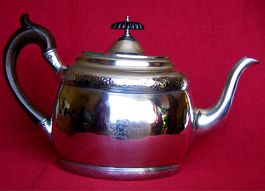
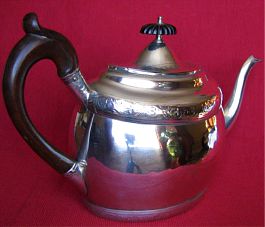 A
most attractive and stylish late eighteenth century Irish bright cut teapot, fashioned
in a shaped oval design with really beautiful decorative details. It has bright
cut decoration on an band round the shoulder of the teapot. It also has bright cut
decoration round the base and also to the lid. The teapot is very clearly hallmarked
with a set of Irish hallmarks for Dublin, made by Richard sawyer,1800.
A
most attractive and stylish late eighteenth century Irish bright cut teapot, fashioned
in a shaped oval design with really beautiful decorative details. It has bright
cut decoration on an band round the shoulder of the teapot. It also has bright cut
decoration round the base and also to the lid. The teapot is very clearly hallmarked
with a set of Irish hallmarks for Dublin, made by Richard sawyer,1800.
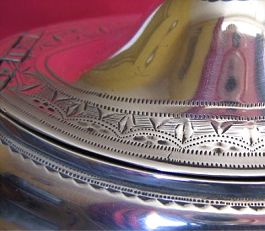
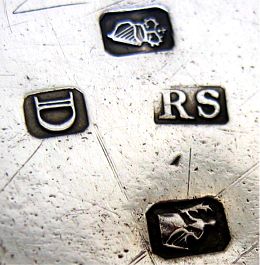
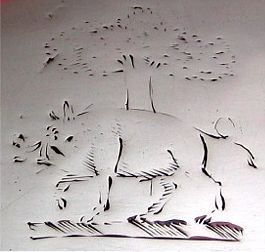 There
is a crest engraved on both sides of the teapot, which is unusual as it usually
only appears on one side. This crest is of a wild boar in front of a tree. These
are original crests to the period of the teapot and would have been the crest of
the original family who owned this charming teapot.
There
is a crest engraved on both sides of the teapot, which is unusual as it usually
only appears on one side. This crest is of a wild boar in front of a tree. These
are original crests to the period of the teapot and would have been the crest of
the original family who owned this charming teapot.
This is certainly a fine George III Irish teapot and one that would be a beautiful addition to a fine afternoon tea table.
More details of this item and other tea related antiques can be found by visiting my web site at www.TeaAntiques.com.
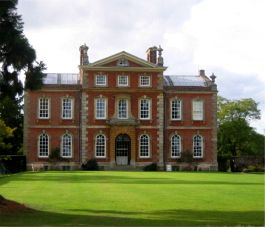 Kingston
Bagpuize House is a stunningly beautiful house that is 'stately in miniature'. It
is a perfectly formed house with large windows and built in elegant red brick with
stone handsome trimmings. The design of the house is harmonious and perfectly balanced,
having a central block with raised pediment, flanked by two lower wings. Interestingly,
the windows on the ground floor have semi-circular tops to them, whereas the first
floor they have shallow curved tops and on the central blocks second floor level
they are square. This change in window shape adds immensely to the architectural
beauty of the design, which to say the least, is pleasing to the eye.
Kingston
Bagpuize House is a stunningly beautiful house that is 'stately in miniature'. It
is a perfectly formed house with large windows and built in elegant red brick with
stone handsome trimmings. The design of the house is harmonious and perfectly balanced,
having a central block with raised pediment, flanked by two lower wings. Interestingly,
the windows on the ground floor have semi-circular tops to them, whereas the first
floor they have shallow curved tops and on the central blocks second floor level
they are square. This change in window shape adds immensely to the architectural
beauty of the design, which to say the least, is pleasing to the eye.
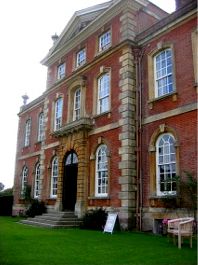 The
roof line is embellished with stone urns with covers, two on the end of the central
block at the base of the pediment and one on each end of the projecting wings. Another
excellent feature about the house is that it is architecturally the same in its
front and back elevations. Also, having the kitchens within the basement still,
there is no attached servant wing to the house, it stands proudly as one uniform
structure.
The
roof line is embellished with stone urns with covers, two on the end of the central
block at the base of the pediment and one on each end of the projecting wings. Another
excellent feature about the house is that it is architecturally the same in its
front and back elevations. Also, having the kitchens within the basement still,
there is no attached servant wing to the house, it stands proudly as one uniform
structure.
There has been a manor house here since the Saxon times. Then, after the Battle of Hastings in 1066 the Manor was granted to Henry de Ferrer by William the Conqueror. Henry de Ferrer leased the Manor in turn to Ralf de Bachepuis. The Bachepuis family remained here at Kingston for more than two hundred years, and it was during this time that the name became anglicised to Kingston Bagpuize.
Passing forward in the history of the house, it was bought in 1670 by Edmond Fettiplace, whose daughter Elizabeth, married John Blandy. It was them and then their heirs who lived at Kingston Bagpuize House until 1912 when it was sold to an MP, Edward Strauss. He did not own the house for long before he went bankrupt and was forced to sell it. It was then purchased at auction by Lord Ebury in 1935. He remained at the house for only four years before selling it to Miss Marie Raphael. Upon her death in 1976 it was passed to her niece, Jean, Lady Grant who was a widow. It was with her second husband Lord Tweedsmuir that she lived here, but in 1995 she gave the estate to her second son Francis. This brings the history up to the present family. Francis, lived at Kingston Bagpuise with his wife Virginia and two young children, until sadly he died in 2003, leaving the house to his wife and two young children Elizabeth and Alexander.
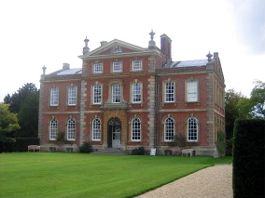 I
can remember the first time I visited Kingston Bagpuise, when Francis was still
alive. I was surprised to see that the person at the gate taking the entrance money
was Francis himself, and giving a wonderful and passionate guided tour was his wife
Virginia. It was really great to see the owners of the house and estate taking such
an active part in its running and upkeep. After the sad passing of Francis in 2003,
Virginia has taken up the challenge to keep the house running and open to the public
to enjoy.
I
can remember the first time I visited Kingston Bagpuise, when Francis was still
alive. I was surprised to see that the person at the gate taking the entrance money
was Francis himself, and giving a wonderful and passionate guided tour was his wife
Virginia. It was really great to see the owners of the house and estate taking such
an active part in its running and upkeep. After the sad passing of Francis in 2003,
Virginia has taken up the challenge to keep the house running and open to the public
to enjoy.
One of the nicest stories I heard when first being shown round the house by Virginia Grant, was that when she was a child, she use to live close by and would walk pass the end of the house drive, from where there is a beautiful view of the house. She would stop to look up at the house, which she adored, never knowing that one day she would marry into the family and from then its owner and carer. Her passion for the house and its future can clearly be heard in talking to her on her personal guided tours.
The house, as we see it today, with its red brick and stone elevations and grand windows is a house rebuilt on the older houses stone basement. The basement portion of the house, which housed the domestic quarters, still retains the smaller stone mullion windows. This remodelling of the principle floors is likely to have taken place c1720.
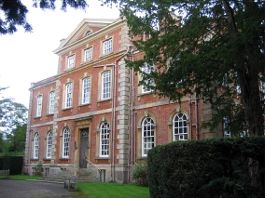 Originally,
the house would have been approached down a long straight driveway from the East
to a paved courtyard in front of the house. Going through the front door into a
stone floored Hall leading on through to a Staircase Hall beyond at the back of
the house. In the mid nineteenth century, this was changed round to have the approach
to the house on the opposite, West side, entering into the Staircase Hall and turning
the old entrance Hall beyond, into a Drawing Room. It is in this way, that we enter
the house today.
Originally,
the house would have been approached down a long straight driveway from the East
to a paved courtyard in front of the house. Going through the front door into a
stone floored Hall leading on through to a Staircase Hall beyond at the back of
the house. In the mid nineteenth century, this was changed round to have the approach
to the house on the opposite, West side, entering into the Staircase Hall and turning
the old entrance Hall beyond, into a Drawing Room. It is in this way, that we enter
the house today.
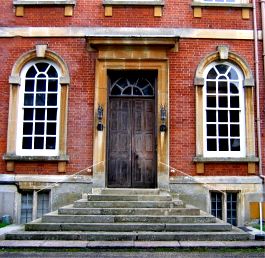 Passing
through what is now the front door of the house, entering the Staircase Hall, the
Staircase sweeps up and above your head as you enter. This magnificent cantilever
staircase dates from the 1720 alterations to the house and is constructed from pine
and oak. It was painted for part of its history, but is now thankfully stripped
to reveal the beauty of the natural wood with its mellow hue and graining.
Passing
through what is now the front door of the house, entering the Staircase Hall, the
Staircase sweeps up and above your head as you enter. This magnificent cantilever
staircase dates from the 1720 alterations to the house and is constructed from pine
and oak. It was painted for part of its history, but is now thankfully stripped
to reveal the beauty of the natural wood with its mellow hue and graining.
On the walls of the hall there are panels of Chinese hand painted wallpaper dating from the early twentieth century and was hung in this position in the 1950's by Marie Rapheal, following her tours of the Far east, in which she had a keen interest. These panels depict flowers such as Peonies and Lilies, around which are exotic birds and butterflies - the butterflies seem contorted in flying upside down. The soft tones used in these paper panels has been enhanced by the recent painting of the Staircase Hall a very subtle pink, perfectly in tune with the background colour of the paper.
On the staircase wall is an early eighteenth century painting showing members of the Grant family at prayer. In the hall are some of the pieces of Chinese porcelain that Marie Grant collected on her tours of the Far east.
Opposite the front door is a door within a large wooden curved topped screen. This door leads into the Drawing Room (once the original stone Entrance Hall). Before the house was turned round to have the front entrance on the West side, this was an open archway, so that guests arriving at the original entrance would enter the Stone Hall, pass into the Staircase Hall and process up to the first floor where there would be one grand Drawing Room or Saloon. Today, the original stone floored Entrance Hall forms a very elegant Drawing Room, its walls hung with attractive yellow floral hangings.
This beautiful room contains some exquisite English Furniture in the form of two most attractive Queen Anne cabinets on stands. Although not a pair, they are very similar in appearance, save the design if the intricate fronts inlaid in rich Laburnum. This Laburnum wood has mellowed and faded on the fronts of the cabinets, but as revealed, by opening the doors on the front show the true original colour and splendour of these pieces. Virginia Grant has a particular passion for early English Furniture and rather dismisses a stunning set of Louis XVI gilt wood furniture! I on the other hand was struck by the beauty of this furniture, comprising arm chairs and settee (the settee has subsequently been moved to an upstairs room). This decorative suite of French furniture is covered with its original Beauvais Tapestry seats and seat backs and remarkably maintaining their original vibrant colours. Interestingly, the covers on the seats depict animals in the centre of the tapestry, whereas on the backs of the chairs there are people depicted in the centre of the tapestry. This is because it was thought ill to be sat on the people, but was okay to sit upon animals.
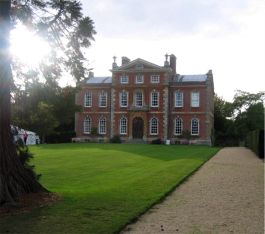 From
the exterior door of the Drawing Room, you look onto the area of lawn which was
once the paved courtyard at the front the house. Beyond this area stand a
set of four huge Washingtonia trees at the head of the straight tree lined 'original'
drive, these trees were planted after the end of the second World War, replacing
the original avenue of trees.
From
the exterior door of the Drawing Room, you look onto the area of lawn which was
once the paved courtyard at the front the house. Beyond this area stand a
set of four huge Washingtonia trees at the head of the straight tree lined 'original'
drive, these trees were planted after the end of the second World War, replacing
the original avenue of trees.
Turning left out of the Drawing Room is The Library, this now used very much as the family sitting room. this small square room is wood panelled room floor to ceiling with its original 1720 pine panelling. there are some good pieces of Georgian furniture to be seen in this room. A variety of cosy chairs are in this room facing the black marble fireplace. A carved mantelpiece holds some Chinese famille Verte porcelain plates and vases - again part of the treasures brought back by Marie Grant on her tours of the Far East.
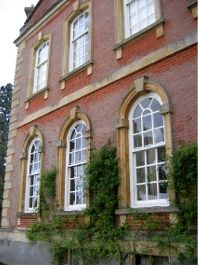 Behind
the Library in the other corner of the house is an even smaller room, aptly named
the Small Sitting Room. This forms a room in which now the family can sit and relax
watching television. However, there is a particularly good English walnut Queen
Anne knee hole writing desk of small proportions. Upon this desk are many recent
family pictures - a nice homely touch.
Behind
the Library in the other corner of the house is an even smaller room, aptly named
the Small Sitting Room. This forms a room in which now the family can sit and relax
watching television. However, there is a particularly good English walnut Queen
Anne knee hole writing desk of small proportions. Upon this desk are many recent
family pictures - a nice homely touch.
Making our way through to the Staircase Hall and up the stairs, there are two bedrooms open to view on the first floor. The Rose Bedroom, contains a four poster bed and Georgian Mahogany furniture. One very nice piece of furniture is a long wardrobe in rich mahogany and having four elegantly reeded columns with Lion Paw feet to support the wardrobe. This is said to be of Irish origin.
The second bedroom, the 'Pink Bedroom' also contains a four poster bed and some more Georgian mahogany furniture. This is a particularly beautiful room as it has double aspect windows, making it a very light room with its tall windows.
Finally, making our way back down to the ground floor via a tightly curving set of servant stairs we enter the Dining Room of the house. Having the original oak panelling from c1720, the room is rather dark. In the centre of the room is the formal oak dining table dating from c1860 and when fully extended would seat 18 people. To one side is a rare Robert Adam side-table, in mahogany. On this side-table are a set of early nineteenth century Irish cut glass decanters and claret jug, the brilliance of the cutting standing out against the darkness of the room like jewels in a casket.
After a pleasing tour, which felt very personal and informal, it was time to enjoy a tea in the basement of the house. The tearooms are set in what was the kitchen of the house, which was in use as a kitchen until 1976. The original kitchen wooden dressers are still in this room, now with a mixture of modern and old kitchen items, including pottery jugs, plates etc. and copper moulds and saucepans. Here there is only cakes and tea to be enjoyed - no savoury food is served, the number of visitors too few to support a full range of food. Despite that, the cakes are home made from natural ingredients. A choice of date and walnut; lemon drizzle cake or a scone with butter and jam is the menu of the day. I had an enjoyable slice of lemon drizzle cake after a scone with butter and jam. Their choice of cakes and food maybe limited, but at least they had a slightly better choice of tea than some. There was Lapsang Souchong and Lady Grey as well as the more usual Assam and Earl Grey teas.
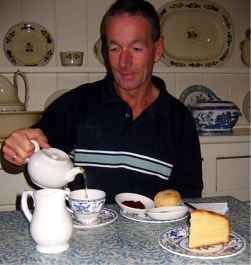
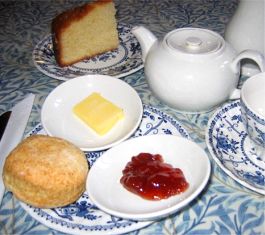
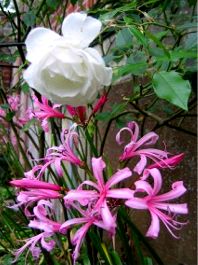
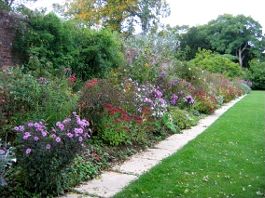
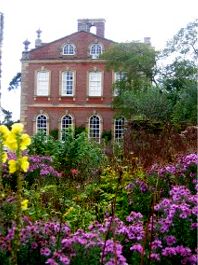 Refreshed,
I took a turn about the gardens. There are herbaceous borders, lawns, woodland garden
and a raised terrace walk to one side of the main lawn terminating at one end with
an early eighteenth century garden pavilion. This charming Pavilion, has wood panelling
and windows similar to those found in the house. Inside the main stone floored room
of the pavilion the wood panelling is painted a soft green, now showing great age.
The sash windows are strewn with old cobwebs, the place left to gentle pressures
of time. There is a narrow spiral staircase within the Pavilion allowing access
from the terrace walk to the ground level of the gardens. At this late time in the
season, my visit here was in October 2004, there were bright pink Nerinie in bloom,
together with Michelmass daisies and soft pink roses. It is a beautiful house in
an enchanted garden. It is a house, though small, I would recommend visiting if
you find yourself in Oxfordshire. I know that you would be made most welcome.
Refreshed,
I took a turn about the gardens. There are herbaceous borders, lawns, woodland garden
and a raised terrace walk to one side of the main lawn terminating at one end with
an early eighteenth century garden pavilion. This charming Pavilion, has wood panelling
and windows similar to those found in the house. Inside the main stone floored room
of the pavilion the wood panelling is painted a soft green, now showing great age.
The sash windows are strewn with old cobwebs, the place left to gentle pressures
of time. There is a narrow spiral staircase within the Pavilion allowing access
from the terrace walk to the ground level of the gardens. At this late time in the
season, my visit here was in October 2004, there were bright pink Nerinie in bloom,
together with Michelmass daisies and soft pink roses. It is a beautiful house in
an enchanted garden. It is a house, though small, I would recommend visiting if
you find yourself in Oxfordshire. I know that you would be made most welcome.
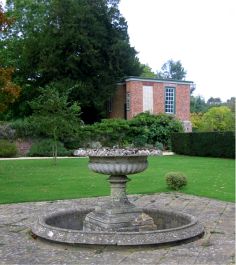
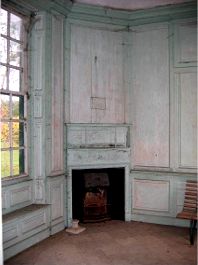
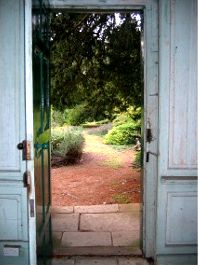
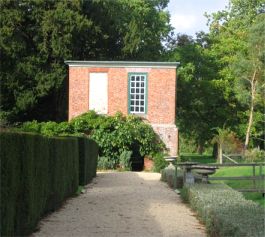
Please do check on the opening times of the house, as it is only open on occasional weekends throughout the year.
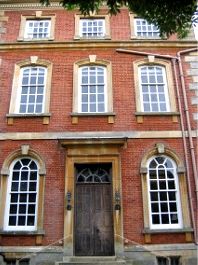
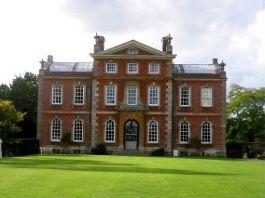
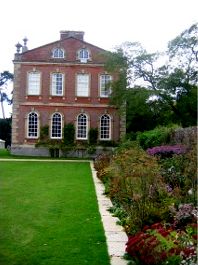
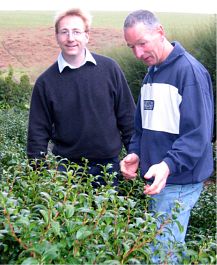 In
March, I was given a personal tour of the Tregothnan estate by its Garden Director,
Jonathan Jones, who is responsible for the estate's tea growing project. Jonathan
has long had a passion for tea and its production, so when he took over as head
gardener in this beautiful estate garden, in which camellias do so well, he thought
that as the tea plant is a member of the Camellia family, that it too may flourish
here.
In
March, I was given a personal tour of the Tregothnan estate by its Garden Director,
Jonathan Jones, who is responsible for the estate's tea growing project. Jonathan
has long had a passion for tea and its production, so when he took over as head
gardener in this beautiful estate garden, in which camellias do so well, he thought
that as the tea plant is a member of the Camellia family, that it too may flourish
here.
The tea plant, Camellia sinensis, has a much stricter pH requirement for its soil growing conditions than the ornamental varieties that can be grown in England. Initially, Jonathan planted single tea plants around the estate to see how they would do in various locations and indeed if they would grow there at all. The results showed that the Camellia sinensis did very well on the estate. With such promising results, it was decided to spearhead a project of growing tea on a larger scale that could result on the first ever English estate grown tea!
Tregothnan was a pioneering garden and was first to introduce Magnolias and to grow Camellias outdoors over 200 years ago. The estate boasts thousands of such ornamental Magnolias and Camellias, some of which tower to over 60 feet. At the time of my visit, there were many beautiful Camellias busting into fantastic colours. Amongst the beautiful Magnolias, the one pictured centre below, is a frequent Chelsea Flower Show 'gold medal' winner.
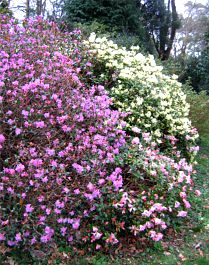
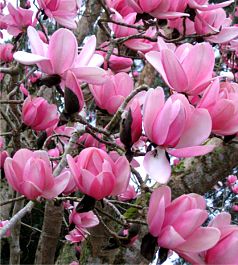
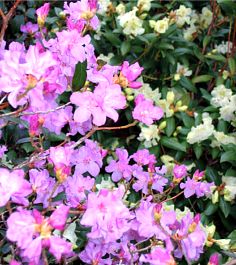
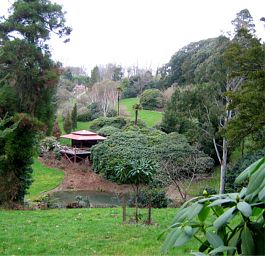
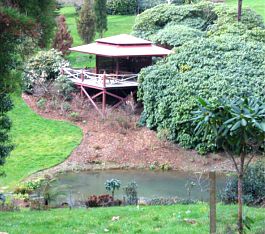 The
Tregothnan estate, is a private estate, only open to the public by appointment.
There is a very fine house on the estate, built in the early nineteenth century,
situated on high ground with views down a long valley to the sea. This natural valley
location gives the gardens a fantastic landscape in which to grow its exotic plant
collection. There are lakes, where at the top end is situated a charming bamboo
summer house in Japanese style. A perfect place to relax.
The
Tregothnan estate, is a private estate, only open to the public by appointment.
There is a very fine house on the estate, built in the early nineteenth century,
situated on high ground with views down a long valley to the sea. This natural valley
location gives the gardens a fantastic landscape in which to grow its exotic plant
collection. There are lakes, where at the top end is situated a charming bamboo
summer house in Japanese style. A perfect place to relax.
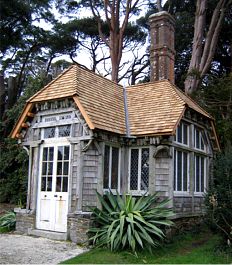 At
one point in the estate is a rustic looking summer, or tea house. Inside this
attractive building is a massive stone open fireplace. This is often used as a tea
house for visitors. There is then a log fire blazing that is used to boil water
for the estate's own tea to be brewed, which is then enjoyed by guests accompanied
by scones, cream and jam. What more relaxing way to enjoy an afternoon tea could
there possible be?
At
one point in the estate is a rustic looking summer, or tea house. Inside this
attractive building is a massive stone open fireplace. This is often used as a tea
house for visitors. There is then a log fire blazing that is used to boil water
for the estate's own tea to be brewed, which is then enjoyed by guests accompanied
by scones, cream and jam. What more relaxing way to enjoy an afternoon tea could
there possible be?
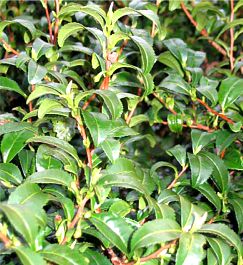 Jonathan
showed me a particular three-year old tea plant that he informed me was a prolific
plant that produced no end of cuttings for propagating new plants for the tea plantation.
This plant was the first I had seen on the estate and had beautiful green shiny
leaves and branches that were already sprouting new shoots. These shoots would soon
be the new tea plants of the future.
Jonathan
showed me a particular three-year old tea plant that he informed me was a prolific
plant that produced no end of cuttings for propagating new plants for the tea plantation.
This plant was the first I had seen on the estate and had beautiful green shiny
leaves and branches that were already sprouting new shoots. These shoots would soon
be the new tea plants of the future.
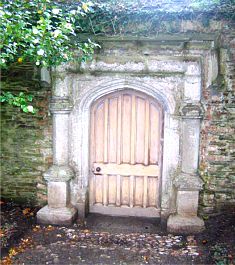 The
growing of tea here started in the 1990's and is now producing its own teas for
sale. As explained to me, tea is usually a complex blend of around thirty different
teas to produce a constant flavour and quality. This makes tea production a little
tricky, being the only tea growing estate in England, they cannot blend their tea
with other teas in the area, so it has to be blended with other teas from China,
Assam and Darjeeling, but the highest proportion of these blends remains the Tregothnan
tea.
The
growing of tea here started in the 1990's and is now producing its own teas for
sale. As explained to me, tea is usually a complex blend of around thirty different
teas to produce a constant flavour and quality. This makes tea production a little
tricky, being the only tea growing estate in England, they cannot blend their tea
with other teas in the area, so it has to be blended with other teas from China,
Assam and Darjeeling, but the highest proportion of these blends remains the Tregothnan
tea.
My tour concluded with a look at the tea plantation, which started in the old sheltered walled garden of the estate, entered through a stone arched doorway. I was amazed to see the lines of rich green camellia sinensis growing within the walled garden. Close inspection of these plants showed that they were just about to flush and become suitable for the first plucking of the season. Plucking is done by hand taking the top two leaves and centre bud of the growth. This tea plantation stretches off down the slopes of the valley and is now producing enough tea to become a commercial venture, much to the delight of Jonathan, who has great plans for the expansion of the project and the creation of an International Tea Centre in the area. This centre is currently going through the planning stage and when open will provide an interesting and exciting insight to the growing, production and drinking of tea. This is a project that I will be eagerly watching and hope to report on just as soon as it is open. I wish Jonathan the best of luck with his plans on this wonderful project.
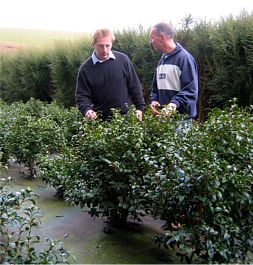
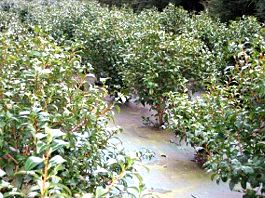
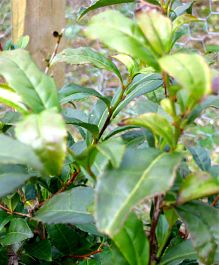
Currently, tea is sold in a small chalet on the edge of the estate or through its website www.tregothnantea.com, for buying on line.
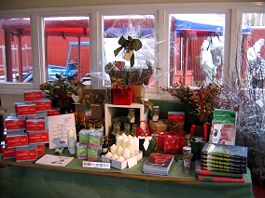

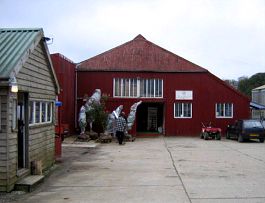
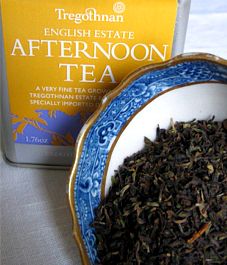 In
last month's Tea Clipper, I enjoyed tasting their 'Classic tea' with my own Chocolate
cake. This time, I am trying another of their own blends, this one the 'Afternoon
Tea'. This blend of tea is a light and exotic blend of the finest Darjeeling tea
and the Tregothnan estate tea. So what did I think of it as an afternoon tea?
In
last month's Tea Clipper, I enjoyed tasting their 'Classic tea' with my own Chocolate
cake. This time, I am trying another of their own blends, this one the 'Afternoon
Tea'. This blend of tea is a light and exotic blend of the finest Darjeeling tea
and the Tregothnan estate tea. So what did I think of it as an afternoon tea?
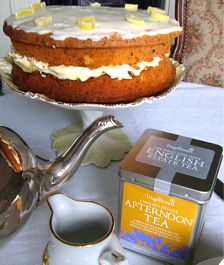 Expecting
Afternoon Tea to have a lighter flavour than the Classic Tea, I accompanied it with
an orange sponge cake, filled with orange flavoured butter cream and bitter Seville
orange marmalade. The actual sponge cake is given a subtle orange flavour by adding
finely grated orange peel to the mixture.
Expecting
Afternoon Tea to have a lighter flavour than the Classic Tea, I accompanied it with
an orange sponge cake, filled with orange flavoured butter cream and bitter Seville
orange marmalade. The actual sponge cake is given a subtle orange flavour by adding
finely grated orange peel to the mixture.
The Tregothnan Afternoon Tea is a blend of Tregothnan home grown tea, with specially imported Darjeeling tea, producing a larger leaf tea than that of the Classic Tea. It produced a really delightful cup of tea. Bright in colour with a slight green tinge and the slightly fresh cut hay bouquet and flavour - I find rather typical in Darjeeling teas. I must say, I found this one of the very finest Darjeeling type teas that I have sampled. It has a good flavour, but unlike some Darjeelings, it did not leave my mouth feeling a bit dry and bitter. I would highly recommend this Tregothnan tea to those who enjoy a good flavourful and crisp afternoon cup of tea.
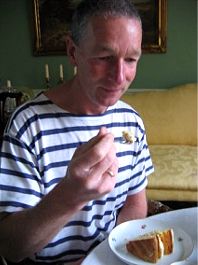
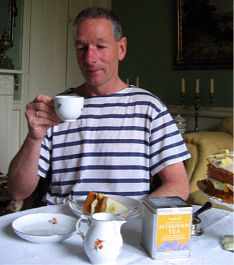
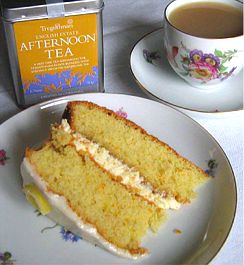
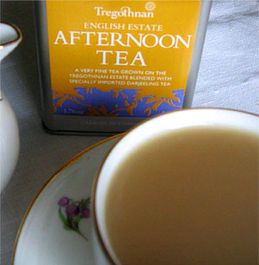
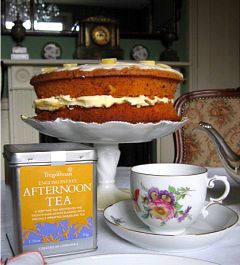 This
tea was an excellent tea to accompany my orange sponge cake, complimenting the light
citrus and fresh flavours within it. I will certainly be drinking this tea at my
afternoon teas when I require a light, bright and extremely refreshing tea.
This
tea was an excellent tea to accompany my orange sponge cake, complimenting the light
citrus and fresh flavours within it. I will certainly be drinking this tea at my
afternoon teas when I require a light, bright and extremely refreshing tea.
As I mentioned in last month's newsletter, these teas are available through mail order from the Tregothnan estate. If you would like to find out more about this fascinating tea plantation at Tregothnan, then visit their web site, which also allows you to buy on line at www.tregothnantea.com.
To review past newsletters, just follow this link:
Past newsletters.
To subscribe to this free newsletter -
Click here